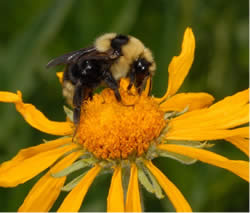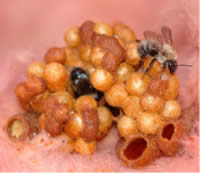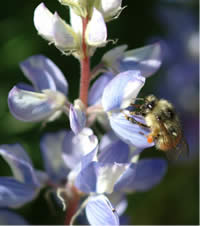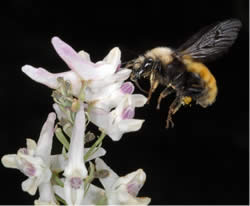Bumblebees (Bombus spp.)
By David Inouye University of Maryland
 A cuckoo bumblebee (Psithyrus insularis) searching for pollen and nectar on sneezeweed (Dugaldia hoopsii). Photo by Dr. David Inouye, University of Maryland.
A cuckoo bumblebee (Psithyrus insularis) searching for pollen and nectar on sneezeweed (Dugaldia hoopsii). Photo by Dr. David Inouye, University of Maryland.
 Bumblebees nest in fiberglass insulation. Photo by Dr. David Inouye, University of Maryland.
Bumblebees nest in fiberglass insulation. Photo by Dr. David Inouye, University of Maryland.
 Bombus flavifrons worker on a lupine flower, carrying a small load of orange pollen. Photo by Dr. David Inouye, University of Maryland.
Bombus flavifrons worker on a lupine flower, carrying a small load of orange pollen. Photo by Dr. David Inouye, University of Maryland.
 Bombus appositus visiting Corydalis caseana. Photo by Dr. David Inouye, University of Maryland.
Bombus appositus visiting Corydalis caseana. Photo by Dr. David Inouye, University of Maryland.
Bumblebees (of the genus Bombus) are common native bees and important pollinators in most areas of North America. In spring, queens emerge from underground where they have spent the winter, and look for a nest site, often found underground in an old mouse nest or rodent burrow. Bumblebees visit flowers for the nectar and pollen upon which they feed, and once the eggs they lay have hatched, they use those plant resources to feed larval worker bees. Bumblebees can generate heat with their flight muscles, and queens will use this ability to incubate their brood and speed up development of the workers. After the first generation of workers hatches, the empty cocoons may be used for short-term storage of nectar, but bumblebees do not make and store large quantities of honey like honeybees (which need ample supplies of honey to make it through the winter).
The bumblebee queen produces a few generations of workers during the summer, which then take over the task of collecting nectar and pollen and help rear the final generation of the colony, queens for the next summer, and males to mate with them. By late fall, the colony has died out except for a few final workers and males, and the new queens burrow into the ground to wait for the following spring.
Bumblebees are important pollinators for many wildflowers. There are 49 species of bumblebees in the United States, which can be separated into three different classes of proboscis (tongue) length: short, medium, and long. This variation in tongue size allows different species of bees to visit different sizes and shapes of flowers. A few of the short-tongued species, however, manage to feed on long-tube flowers by “nectar robbing”. They bite holes in the flowers near the nectaries and extract the nectar through the hole instead of visiting the flowers “legitimately”.
Another reason bumble bees are important pollinators is their behavior of buzzing, or sonicating, flowers that require this behavior for pollination. For example, tomatoes and some other flowers in that plant family don’t produce nectar but the bees visit them anyway in order to collect pollen, which they do by vibrating their wing muscles (making a buzzing noise) to shake pollen grains out of the anthers.
As one of the few species of commercially developed pollinators, a few species of bumblebees have been shipped to a variety of places around the world where they are not native but are wanted for greenhouse pollination. They typically forage outside of the greenhouses as well. As a result, they have been implicated in transmitting new diseases to wild, native bumblebees. They have also escaped from the greenhouses becoming feral in places where they are not native. They may become competitors with native species and serve as pollinators for introduced weeds.
Bumblebees are also a conservation issue, as they are sometimes threatened by human activities such as habitat fragmentation, pesticide use, disease transmission, and loss of floral resources. In the past few years, it appears that two species of bumblebees have gone extinct in the United States. Franklin’s bumblebee (Bombus franklini) is (or was) an endemic species with the most restricted geographic range of any bumblebee in North America and possibly the world. Its range, known at one time to span from southwest Oregon to northwest California, was quite restricted, but it has not been found despite intensive searches during the past few summers. Another species from the eastern United States, which was once found from Canada to North Carolina, also seems to have disappeared in the past few years.
For Additional Information
- North American Pollinator Protection Campaign
- The Pollinator Partnership
- Dr. David Inouye, University of Maryland Department of Biology
- National Academies News: Some Pollinator Populations Declining; Improved Monitoring and More Biological Knowledge Needed to Better Assess Their Status
- Bumble Bees of the Eastern United States (PDF, 5.9 MB), by Sheila Colla, Leif Richardson, and Paul Williams. A product of the USDA Forest Service and the Pollinator Partnership with funding from the Naitonal Fish and Wildlife Foundation.
- Bumble Bees of the Western United States (PDF, 7.7 MB), by Jonathan Koch, James Strange, and Paul Williams. A product of the USDA Forest Service and the Pollinator Partnership with funding from the Naitonal Fish and Wildlife Foundation.
- Bumblebee Specialist Group - The initial priorities of the Bumblebee Specialist Group are to implement a comprehensive and detailed assessment of the global status of all bumblebee species, based on the International Union for Conservation of Nature (IUCN) Red List criteria, as well as to promote bumblebee conservation worldwide.
- The Arctic Bumblebee (Bombus polaris)

